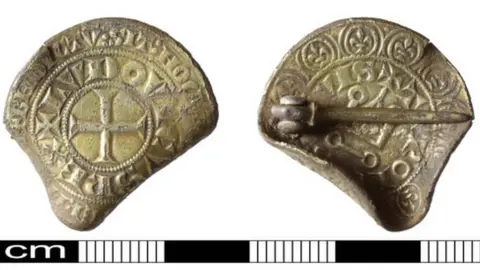Medieval coin brooch found in Norfolk 'was not worn by peasant'
 Norfolk County Council
Norfolk County CouncilA medieval brooch made from a French coin and found in a Norfolk field "was not worn by a peasant", an expert said.
The gilded silver jewellery, made from a gros tournois from Louis IX's reign, was found in the Wymondham area.
Dr Adrian Marsden said the style of brooch was fashionable between the 11th and 14th Centuries.
As the coin was worth more than a day's wages, it showed "someone reasonably well off dropped it", he said.
The brooch, made from a coin struck between 1266 and1270, and measuring 25.6mm (one inch) in diameter, was found by a metal detectorist in September.
It was thought it was turned into jewellery not long after being struck, as the peak of the fashion for coin jewellery was between 1250 and 1300, and its popularity declined in the early 1400s.
 Getty Images
Getty ImagesDr Marsden, a numismatist with the Norfolk Historic Environment Service, said the English penny was "rather small" and not as popular.
"To get a decent brooch, many silver coins were imported from the continent... many were the gros tournois from France - if you wanted it to be more eye-catching," he said.
"We find a few [in Norfolk] but not many," Dr Marsden said, and "they don't turn up as coin finds, so it looks like most were used as jewellery".
"It is significant more as an item which shows what people were wearing and how a foreign coin was pressed into function," he said.
"What it really shows is that someone reasonably well-off dropped it.
"This is [worth] a good couple of days' wages, which is a reasonable sum, so not something a peasant would have worn.
"But I regard everything that turns up as a jigsaw and every field in Norfolk is part of that jigsaw.
"Every object found is really telling us a story."

Find BBC News: East of England on Facebook, Instagram and Twitter. If you have a story suggestion email [email protected]
